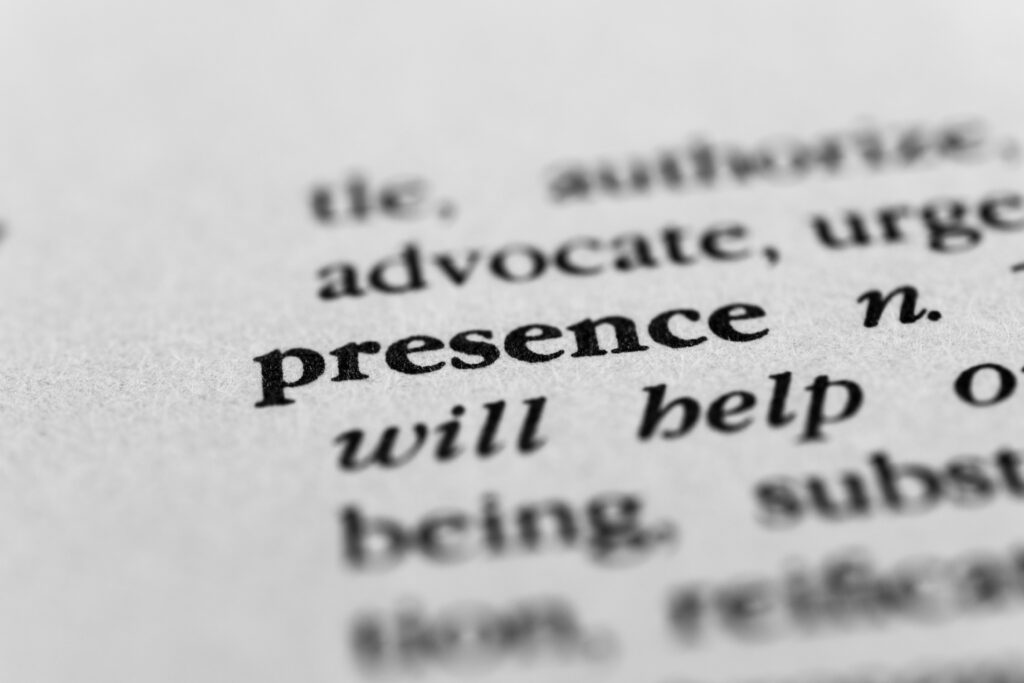In this Article...quick links
- What does it mean to speak with gravitas?
- Why is gravitas, or executive presence, important?
- How to develop authentic gravitas and executive presence?
- Techniques to help you speak with gravitas when presenting
- How to speak with gravitas – fine-tuning
- One final tip on how to speak with gravitas
- Develop your executive style and build gravitas through training or 1-to-1 coaching.
 We know it the instant we see it. That certain ‘je ne sais quoi.’ Those people who seem to have a natural ability to command the room, captivate an audience, and have listeners hanging off their every word. Sir David Attenborough, Bill Gates, Oprah Winfrey and Barrack Obama, to name just a few, have all got it. So, what is it that they all have in common? They speak with GRAVITAS! As a result, they are trusted and respected. Their ideas are valued. And what they say is deemed to be important. And it’s not just those on the world stage that have gravitas. I’m sure you can think of people in your professional and personal life that have that ‘magic touch’ as well.
We know it the instant we see it. That certain ‘je ne sais quoi.’ Those people who seem to have a natural ability to command the room, captivate an audience, and have listeners hanging off their every word. Sir David Attenborough, Bill Gates, Oprah Winfrey and Barrack Obama, to name just a few, have all got it. So, what is it that they all have in common? They speak with GRAVITAS! As a result, they are trusted and respected. Their ideas are valued. And what they say is deemed to be important. And it’s not just those on the world stage that have gravitas. I’m sure you can think of people in your professional and personal life that have that ‘magic touch’ as well.
What does it mean to speak with gravitas?
Gravitas – ‘dignity, seriousness, or solemnity of manner’ – OED.
From the Latin noun gravitas, which means weight or heaviness. In today’s world, we associate gravitas with several meanings including influence, importance, authority and seriousness or composure of conduct. In ancient history, it was used widely by the Romans to describe the essential characteristic required (by a male!) to govern at any level.
A question we often get asked is ‘Are we born with gravitas (or executive presence as it’s often referred to in business)? Or is it a skill that can be developed?’ We believe in both! Yes, some people naturally have gravitas. And yes, we can all learn the skills required to have greater gravitas.
In this article, we’ll start by looking at why gravitas, or executive presence, is important. We’ll then touch on how to develop more gravitas and executive presence. Our main focus though will be on sharing simple techniques that you can put into practice straight away to enhance your gravitas and executive presence as a presenter. We’ll finish by sharing some additional suggestions for fine-tuning it.
By the way, we have another piece teaching you more about the silent art of on-screen gravitas as well, for those remote work days.
Why is gravitas, or executive presence, important?
Have you ever met a CEO or senior executive who can’t communicate clearly or get their ideas across; who fails to command the respect of others; who lacks leadership skills; or who seems out of their depth? Unlikely. That’s because having people at the ‘top table’ who speak with gravitas plays a key role in business success.
Speaking with gravitas means your ideas and voice are taken seriously, your input is sought out and valued, and you are more likely to gain the trust and respect of those around you. Not only that, but leaders who know, or have learned, how to speak with gravitas are more likely to inspire and motivate employees, increase staff engagement and drive company productivity. So, it’s not surprising that when companies are seeking to fill senior management positions being able to communicate with executive presence is usually a non-negotiable ‘must have’.
How to develop authentic gravitas and executive presence?
A word of caution if you want to enhance your gravitas and leadership presence. First and foremost, it is important to be your authentic self. If you try to behave differently in an attempt to build gravitas then your imposter status will be quickly revealed to others. To avoid this, try for one moment to think of yourself as a brand. Then consider what qualities and values you believe other people associate with your brand (are these qualities and values that you would admire in someone else?). Now focus on those that are the most important for you.
By identifying your inherent values and qualities you’re defining your personal ‘brand essence’. This is an important step in understanding your own executive style.
If you can commit to your values every day and let them guide your actions and voice in every situation then it is possible to increase your gravitas and your ability to stand out from those around you, just by being your true self.
By the way, if you think you may have some qualities which are less than positive you might want to consider getting some feedback and coaching to manage these traits. More on that at the end of this post.
Techniques to help you speak with gravitas when presenting
There are a number of techniques that you can use that will certainly help you to understand how to speak with gravitas and improve your executive presence when presenting. They’ll also increase your confidence as a speaker. So, let’s go through them in more detail.
Speak slowly
We can’t emphasise this one enough. People with executive presence don’t rush their speech – they know from experience that to speak with gravitas they need to talk more slowly.
And yet it’s one of the most common mistakes that inexperienced presenters make. It makes them sound rushed and appear nervous. It’s also difficult for the audience to take in the true meaning of what they are saying, and so more than likely, they’ll start to tune out.
Speaking slowly will actually help you to feel more relaxed and appear more poised. It also provides the opportunity to add more weight, more gravitas, to each word. It allows you to emphasise keywords, add emotion to particular messages, and keep in time with your thoughts. The audience will also be more engaged because they are not verbally overwhelmed.
A good way to practice speaking more slowly is to imagine your presentation as a written narrative, with commas, underlined or bolded words, full stops, new paragraphs and exclamation marks. If you were reading it you would mentally take these grammatical cues and their subsequent pauses and annotations into account. The trick is to do the same when presenting.
Vary your tone of voice
There’s nothing worse than listening to a monotone voice for minutes on end, even if the subject is interesting. To dial up your executive presence as a presenter use your voice to reflect different content within a presentation and to bring your story to life. For example, use higher tones to convey enthusiasm and create excitement and use lower tones when you are talking about something more solemn or serious. If you don’t believe how effective this can be, record yourself delivering 2 minutes of a presentation in a dull unemotional voice. Then record the same 2 minutes using your voice to add colour, depth and meaning to what you are saying. You’ll be amazed at the difference.
The role of pausing
NEVER underestimate the power of the pause. Presenting and incorporating more, and longer, pauses is one of the best examples we have of how to speak with gravitas! It signals confidence and authority and enhances listener engagement. Furthermore, it provides emphasis, drama and verbal punctuation. It also allows the audience to fully understand and digest key messages before moving on to another topic or line of thought. It’s no wonder senior leaders and polished presenters focus so much on mastering the skill of pausing!
Nine types of pauses
The legendary British voice coach, actor, director and academic, Ron Arden, used to teach his students about the nine types of pauses and when they should be used.
- Sense Pause. Think of it as a comma, a punctuation mark to allow the audience to keep up with what you are saying. Usually, a pause of around a half to one and a half seconds.
- Transition Pause. This is the full-stop pause and should be used to punctuate and separate one idea or thought from another. Timing is around two seconds.
- Pause for Effect. Also around 2 seconds, this pause allows time for the final thought to be mulled over and creates a feeling of anticipation for the next part of the presentation.
- Spontaneity Pause. Designed to keep the audience engaged, this short pause is most effective when used in conjunction with a gesture, such as raising a finger or a change in facial expression. It gives the audience the impression that this idea has just come to you rather than it being a well-rehearsed or familiar point.
- Sensory Pause. This is a good way to take your audience on a journey if you want to get them to imagine a situation or feeling at the same time as you. For example, “The rain was thundering down outside, “(pause), “It was so loud that it drowned out the voice on the radio,” (pause). With each pause, you are giving the audience time to create their own visual representation before moving on.
- Pause for emphasis. This is more of a reminder to yourself to stop yourself from speaking at the same pace and tone for too long. It’s a pause that acts like the clutch in a manual car i.e. it enables you to ‘change gears’ vocally. When you are making a point you want to emphasise, you should pause beforehand to change vocal gears and then pause afterwards so the message has time to fully land with the audience.
- Dramatic Pause. This is similar to the emphasis pause but it’s longer, anywhere up to 7 seconds, and is designed to give maximum impact to the next point that you make. Just make sure it’s something worth waiting for!
- Reflective Pause. Anywhere from 3 to 7 seconds, this pause is designed to allow the audience time to digest and understand a complex idea.
- Pause to relinquish control or hand over. This is useful if you are handing over to another speaker or answering questions. Always pause before you answer a question to give yourself time to think and to show the questioner that you are giving their question due consideration. Pause again after your answer to indicate that you have finished.
Those who know how to speak with gravitas know how to keep people engaged. Constant stimulation is one of their secrets. So, the next time you’re practising a presentation make sure you know when and where to use the pause, and for how long, to add spontaneity, emphasis or drama to your speech.
Body language
How to speak with gravitas is not just about how to speak with your voice, but how to communicate with your whole body!
Your body language, or non-verbal cues, can dramatically increase or decrease the impact of your words and help to magnify your executive presence in the room. Work on finding your comfortable, and yet assertive, neutral position. If you are standing up then be aware of your posture, relax your shoulders and arms and make sure your hands are at waist level or slightly above. Return to this position when you are not gesturing, moving, or directing the audience’s attention to a particular point on a slide. If you are sitting down, then make sure your hands are relaxed and on the table. Don’t be tempted to put your hands on your lap as this will decrease your presence and make you look timid, or worse submissive.
Think about your ‘brand values’ that define your executive style and make sure you don’t give away any non-verbal cues that might contradict these values; eye rolling, fidgeting, frowning, or raised eyebrows, etc. Instead, adopt positive cues like nodding, making eye contact and smiling.
Gestures
Used appropriately, gestures can greatly increase executive presence. Think of your hands as a second, powerful communication tool. ‘Steepling’, holding the ball’, and counting off your fingers are great ways to add gravitas to your words. Palms-up gestures indicate honesty and integrity, while palms-down gestures convey authority, strength and control. Check out our piece on what to do with your hands when presenting, for a list of dos and don’ts when it comes to using gestures as a complementary communication tool utilised by many great leaders.
Moving with purpose
Presenters who move naturally and in control immediately appear to have more gravitas. It’s as if they’re physically ‘owning the room’. Think about how and when to move with purpose to enhance your presence as well as to punctuate your presentation. With movement you control the audience’s attention, either towards you, so they are concentrating on what you are saying, or away from you and towards a specific point on a slide. If you have divided your presentation into chapters, then think about moving to a different position to deliver each chapter, or to land key messages along the way.
Remember that if you are at the front of the room or stage the focus will be entirely on you. If you are beside the screen, the focus will be evenly split between you and your slides, and if you are at the side of the room the focus will be solely on your slides. We call this the Attention Triangle. So, consider how, with your executive presence, you can manage the engagement of your audience and enhance your presenting gravitas.
Eye contact
As another important, non-verbal cue, your eyes can convey so many things; integrity, interest, empathy, hostility or aggression, surprise and affection. Remember to make positive and genuine eye contact, or what we call Eye Connection, with individuals within your audience. Ask anyone what they notice when in the presence of a great leader and they will invariably say that they felt really important, even if for just a moment, because their eye contact was so strong and sincere. Give it a go and notice the difference.
Remember to smile
Not all the time, that would be cheesy, but smiling at the appropriate time is a great way to communicate warmth and empathy. It’s also highly contagious! Not all people with gravitas are good at smiling, but we think the best ones are. Reflect on those people you know who you believe have strong gravitas and leadership presence and let us know what you think!
All these techniques are easy to put into practice, not just for presentations but in our daily communications. So, if you’re looking to develop more gravitas and leadership presence why not start applying them today?
While practice makes perfect, you don’t want to be practising the wrong things! We’ve put together even MORE of our top tips on presentation skills so that you can start using them today and keep your audience engaged.
How to speak with gravitas – fine-tuning
Aside from adding gravitas when presenting and communicating, there are additional things that you can do to fine-tune how you develop and increase your executive presence.
Seek feedback
Many organisations regularly conduct 360° reviews among peers and those reporting to you. Make the most of this information and let it help you to improve your executive style. Do not think of it as criticism, but rather a road map to help you to grow.
Make the most of mentor and training programmes
Following on from the suggestions above, if your company has an L&D budget ask if you can have access to an executive coach or mentor. This is a great opportunity to get personalised feedback and provides constructive and expert learning that will improve your presentation and leadership skills. Check out our information page to discover how we can partner with you.
Be a good listener
We are all busy, rushing from one meeting to another and it can be easy to lose touch with the people we work with. Make time to regularly ask them how things are going. What’s motivating them? What isn’t? What concerns do they have? What extra support do they need? What ambitions do they have for the future? Being a passionate listener, one that is truly present for others, both shows and builds respect. And from this respect comes strong connections with colleagues and staff. Empathy, demonstrating interest and finding solutions, will strengthen your brand values and increase not only your executive presence but you’re your reputation.
One final tip on how to speak with gravitas
This is fun but effective too! Find a song or piece of music that helps you to set the right mood for the gravitas and presenting style you would like to project.
Choose something that reflects your brand values and conjures up the executive presence that you have in your mind. The lyrics don’t matter so much as how you feel when you hear them. Ideally, it will be a tune that also reminds you to speak more slowly, helps you to feel relaxed, and confident, and to exude that ‘extra something when you think of it.
Having gone through my music library I felt instantly drawn to Bach’s Cello Suite No.1 in G. This piece makes me think of effortless power combined with poise and grace. A bit like our late Queen Elizabeth II. Or, if I’m wanting something more uplifting then for me Whitesnake’s Here We Go Again works every time.
Of course, I’m not suggesting that my tastes will work for you. So, I encourage you to identify a piece of music that does. You could go one step further and create your own personal gravitas playlist. Whenever you are about to present listen to the music in your head and let it guide your pace and style!
Develop your executive style and build gravitas through training or 1-to-1 coaching.
If you’re looking for help on how to speak with gravitas, for yourself, or your team, our personalised training or coaching that is tailored to your business, is just what you’re looking for!
For nearly 20 years we have been the Business Presentation Skills Experts, training & coaching thousands of people in an A-Z of global blue-chip organisations – check out what they say about our programmes.
To find out more, click on one of the buttons below:

Belinda is the Co-Founder and Managing Director of SecondNature International. With a determination to drive a paradigm shift in the delivery of presentation skills training both In-Person and Online, she is a strong advocate of a more personal and sustainable presentation skills training methodology.
Belinda believes that people don’t have to change who they are to be the presenter they want to be. So she developed a coaching approach that harnesses people’s unique personality to build their own authentic presentation style and personal brand.
She has helped to transform the presentation skills of people around the world in an A-Z of organisations including Amazon, BBC, Brother, BT, CocaCola, DHL, EE, ESRI, IpsosMORI, Heineken, MARS Inc., Moody’s, Moonpig, Nationwide, Pfizer, Publicis Groupe, Roche, Savills, Triumph and Walmart – to name just a few.





